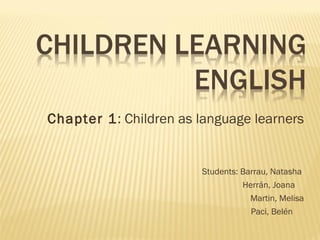
Children Learning English
- 1. Chapter 1: Children as language learners Students: Barrau, Natasha Herrán, Joana Martin, Melisa Paci, Belén
- 2. 1) CONTEXT FOR LEARNING ENGLISH Necessary conditions for a learning situation: Time Exposure A real need for English Variety of input Meaningful input
- 3. MAKING A CLASSROOM A POSITIVE LEARNING ENVIRONMENT: Use attractive wall displays, displays of pupil’s work, etc. Use interesting and enjoyable learning activities. Create a warm and happy atmosphere. Help pupils to develop personal reasons for learning English.
- 4. 2) CHILDREN AS LANGUAGE LEARNERS How do children learn a foreign language? Children use language creatively. They have knowledge of the language system. They try to experiment and work out the rules of the language in their heads. Students need opportunities to try out and work with language, but they also need a feedback to confirm or modify their hypotheses.
- 5. GOING FOR MEANING Children have a good instinct for interpreting sense or meaning of a situation. They work out the meaning, and do not pay much attention to the words.
- 6. USING “CHUNKS” OF LANGUAGE Children use complete phrases or formulas learned as a whole. Examples: I don’t know. Come on. Goodbye. Then, children start to break down the phrases and recombine the words in new ways. Sign of language development
- 7. HAVING FUN Children have a great capacity to enjoy themselves. If pupils enjoy the learning activities The desire to continue increases. More exposure to input. More opportunities to practise the language.
- 8. JOINING IN THE ACTION Children construct their understanding of the world by exploring the environment and interacting with people. Physical activities provide excellent contexts for language learning “Children learn through doing”
- 9. TALKING THEIR HEADS OFF In general, young children (5 to 10-year-olds) are enthusiastic and eager to talk in class. Children’s desire to communicate is very powerful. If they are engaged with the activity, they will talk their heads off happily.
- 10. FEELING AT HOME o Pupils often feel frightened, embarrassed or insecure about learning a language. They will participate, take risks and enjoy L2 learning if they feel at home. o Teachers should create an appropriate learning environment where children can develop the abilities they have and encourage their students. o Teachers should be aware of students’ feelings and support them in the learning process of the L2 creating conditions which support language learning.
- 11. AN APPROPRIATE LEARNING ENVIRONMENT TO DEVELOP CHILDREN’S ABILITIES o Create a real need and desire to use English. o Provide time for English, exposure to varied and meaningful input, opportunities to practise, experiment and use the language in different contexts . o Create a friendly atmosphere in which children can take risks and enjoy their learning. o Provide feedback on learning. o Help children notice the underlying pattern in language.
- 12. 3) HOW TEACHERS’ BELIEFS ABOUT LEARNING AFFECT THEIR TEACHING? o Teachers’ beliefs about learning will affect the plan and organization of their lessons as well as the attitude towards pupils and language. o We are not aware of our beliefs until we hear someone else’s opinion. o Our beliefs about learning will also affect the kind of relationships we build with pupils.
- 13. 4) WAYS OF OBSERVING CHILDREN’S LANGUAGE LEARNING Teacher’s beliefs affect the way we plan our teaching and the way we respond to young learners.
- 14. HOW TO BECOME BETTER AT WATCHING AND LEARNING FROM PUPILS Keep a diary: write down things you observe children say and do. Plan future lessons or provide specific help. Tape record children’s pair group interaction: Example, tape record children doing a particular language-learning activity.
- 15. SUMMARY We have seen: The different contexts in which children can learn English and how these affect the quantity and quality of language input children get. The variety of ways a children learn and the abilities and characteristics children make use of in learning another language How teacher’s beliefs affect the way they teach. Ideas for observing children.
- 16. Children learning a second or foreign language will use similar processes of acquisition BUT The difference lies in the type and amount of language exposure. Teacher: powerful position: positive, stimulating and successful experience